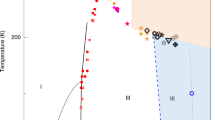Abstract
Hydrogen strongly affects the electronic and structural properties of many materials. It can bind to defects or to other impurities, often eliminating their electrical activity: this effect of defect passivation is crucial to the performance of many photovoltaic and electronic devices1,2. A fuller understanding of hydrogen in solids is required to support development of improved hydrogen-storage systems3, proton-exchange membranes for fuel cells, and high-permittivity dielectrics for integrated circuits. In chemistry and in biological systems, there have also been many efforts to correlate proton affinity and deprotonation with host properties4. Here we report a systematic theoretical study (based on ab initio methods) of hydrogen in a wide range of hosts, which reveals the existence of a universal alignment for the electronic transition level of hydrogen in semiconductors, insulators and even aqueous solutions. This alignment allows the prediction of the electrical activity of hydrogen in any host material once some basic information about the band structure of that host is known. We present a physical explanation that connects the behaviour of hydrogen to the line-up of electronic band structures at heterojunctions.
This is a preview of subscription content, access via your institution
Access options
Subscribe to this journal
Receive 51 print issues and online access
$199.00 per year
only $3.90 per issue
Buy this article
- Purchase on Springer Link
- Instant access to full article PDF
Prices may be subject to local taxes which are calculated during checkout


Similar content being viewed by others
References
Pankove, J. I. & Johnson, N. M. Semiconductors and Semimetals Vol. 34, Hydrogen in Semiconductors (Boston, Academic, 1991)
Blöchl, P. & Stathis, J. H. Hydrogen electrochemistry and stress-induced leakage current in silica. Phys. Rev. Lett. 62, 372–375 (1999)
Schlapbach, L. & Züttel, A. Hydrogen-storage materials for mobile applications. Nature 414, 353–358 (2001)
Mills, B. E., Martin, R. L. & Shirley, D. A. Further studies of the core binding energy-proton affinity correlation in molecules. J. Am. Chem. Soc. 98, 2380–2385 (1976)
Van de Walle, C. G. & Johnson, N. M. in Semiconductors and Semimetals Vol. 57, Gallium Nitride (GaN) II (eds Pankove, J. I. & Moustakas, T. D.) 157–184 (Academic, Boston, 1998)
Van de Walle, C. G. Hydrogen as a cause of doping in ZnO. Phys. Rev. Lett. 85, 1012–1015 (2000)
Hofmann, D. M. et al. Hydrogen: a relevant shallow donor in zinc oxide. Phys. Rev. Lett. 88, 045504 (2002)
Limpijumnong, S. & Van de Walle, C. G. Passivation and doping due to hydrogen in III-nitrides. Phys. Status Solidi B 228, 303–307 (2001)
Franciosi, A. & Van de Walle, C. G. Heterojunction band offset engineering. Surf. Sci. Rep. 25, 1–140 (1996)
Bockstedte, M., Kley, A., Neugebauer, J. & Scheffler, M. Density-functional theory calculations for poly-atomic systems: Electronic structure, static and elastic properties and ab initio molecular dynamics. Comput. Phys. Commun. 107, 187–222 (1997)
Louie, S. G., Froyen, S. & Cohen, M. L. Nonlinear ionic pseudopotentials in spin-density-functional calculations. Phys. Rev. B 26, 1738–1742 (1982)
Van de Walle, C. G. & Martin, R. M. Theoretical calculations of heterojunction discontinuities in the Si/Ge system. Phys. Rev. B 34, 5621–5634 (1986)
Van de Walle, C. G. Band lineups and deformation potentials in the model-solid theory. Phys. Rev. B 39, 1871–1883 (1989)
Majewski, J. A., Städele, M. & Vogl, P. Stability and band offsets of SiC/GaN, SiC/AlN, and AlN/GaN heterostructures. Mater. Res. Soc. Symp. Proc. 449, 917–922 (1997)
Yu, E. T., McCaldin, J. O. & McGill, T. C. in Solid State Physics Vol. 46 (eds Ehrenreich, H. & Turnbull, D.) 1–146 (Academic, Boston, 1992)
Look, D. C. et al. Donor and acceptor concentrations in degenerate InN. Appl. Phys. Lett. 80, 258–260 (2002)
Janotti, A., Zhang, S. B., Wei, S.-H. & Van de Walle, C. G. The effects of hydrogen on the electronic properties of GaAsN alloys. Phys. Rev. Lett. 89, 086403 (2002)
Ledebo, L. Å. & Ridley, B. K. On the position of energy levels related to transition-metal impurities in III-V semiconductors. J. Phys. C 15, L961–L964 (1982)
Caldas, M. J., Fazzio, A. & Zunger, A. A universal trend in the binding energies of deep impurities in semiconductors. Appl. Phys. Lett. 45, 671–673 (1984)
Tersoff, J. & Harrison, W. A. Transition-metal impurities in semiconductors — their connection with band lineups and Schottky barriers. Phys. Rev. Lett. 58, 2367–2370 (1987)
Tersoff, J. Theory of semiconductor heterojunctions: The role of quantum dipoles. Phys. Rev. B 30, 4874–4877 (1984)
NIST Chemistry WebBook 〈http://webbook.nist.gov/chemistry〉 (March 2003).
Mejias, J. A. & Lago, S. Calculation of the absolute hydration enthalpy and free energy of H+ and OH-. J. Chem. Phys. 113, 7306–7316 (2000)
Grätzel, M. Photoelectrochemical cells. Nature 414, 338–344 (2001)
Tuttle, B. R. Ab initio valence band offsets between Si(100) and SiO2 from microscopic models. Phys. Rev. B 67, 155324 (2003)
Acknowledgements
We thank S. Limpijumnong, M. Fuchs, M. Chabinyc, D. Biegelsen and the late J. McCaldin for discussions and support. This work was supported in part by the Air Force Office of Scientific Research and by the Deutsche Forschungsgemeinschaft.
Author information
Authors and Affiliations
Corresponding author
Ethics declarations
Competing interests
The authors declare that they have no competing financial interests.
Rights and permissions
About this article
Cite this article
Van de Walle, C., Neugebauer, J. Universal alignment of hydrogen levels in semiconductors, insulators and solutions. Nature 423, 626–628 (2003). https://doi.org/10.1038/nature01665
Received:
Accepted:
Issue Date:
DOI: https://doi.org/10.1038/nature01665
Comments
By submitting a comment you agree to abide by our Terms and Community Guidelines. If you find something abusive or that does not comply with our terms or guidelines please flag it as inappropriate.



